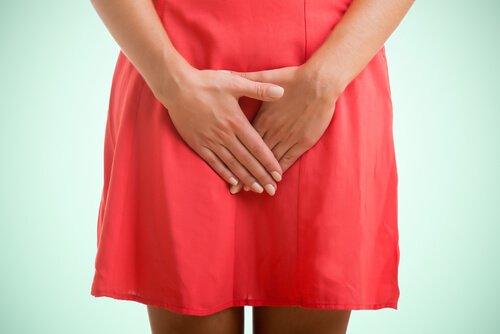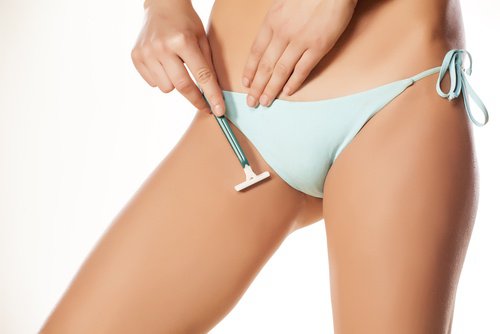Vaginal Itching - Are You Affected by It

Itching in the vaginal region is a common problem that often worries women. Often, it occurs when there’s an imbalance in the pH of the area either due to infections or improper use of hygiene products. However, there are many other causes.
As a study published in Dermatologic Clinics points out, the causes of vaginal itching could be inflammatory, environmental, neoplastic or infectious. What’s more, in many cases, there are multiple contributing factors at the same time.
So, if you experience this symptom, it’s important to be on the look out for any other forms of discomfort. In addition, you must consider whether you may have been exposed to any potential triggers. If so, it’s best to consult a doctor or a gynecologist for advice on how to properly address it.
Reasons why you might have vaginal itching
There are many factors that could explain the appearance of vaginal itching. According to a study published in BioMed Research International, hormonal changes, changes in the composition of the vaginal microflora and changes in vulvovaginal pH are frequent reasons for this symptom.
But, beyond this, there are more concrete reasons to explain this symptom. These are generally related to a hormonal or pH imbalance. It’s important to obtain a proper diagnosis – the success of the treatment depends on it.
1. Yeast infection
Vulvovaginal Candidiasis, a fungal infection, is one of the most common causes of vaginal itching. According to data found in the National Center for Biotechnology Information, this infection is caused by the proliferation of the fungus Candida albicans, which is usually part of the normal vaginal microbiota.
However, when it grows and penetrates the mucous lining of the vagina, it triggers an inflammatory response that leads to a variety of different symptoms. In addition to itching, you may also notice secretions, dyspareunia, and swelling.

We recommend you read Vaginal discharge and your health
2. Vulvitis and vaginal itching
Vulvitis is usually more frequent among postmenopausal women due to the decrease in their estrogen levels. This is the medical term given to vulvar irritation.
Its most characteristic symptoms are swelling and redness of the genital area, accompanied by itching. According to information in the MSD Manual, it may also be caused by:
- Pubic lice.
- Yeast infections.
- Sexually transmitted diseases.
- Skin disorders such as dermatitis.
- Allergies to substances that come into contact with the vulva, such as soaps, perfumes, and even fabrics.
We recommend you read How to prevent herpes naturally
3. Hair removal
There are many hair removal techniques that lead to itching in the vagina immediately after their use. This is because the skin in this area is highly sensitive and has a tendency to manifest allergic reactions.
Manual razors, electric razors and even creams can lead to skin irritation and ingrown hairs that become infected. In addition, the fabric of some clothes tends to rub on the shaved area, increasing irritation.

4. Sexually transmitted diseases
In rare cases, vaginal itching is caused by an STD; however, it’s important to consider that it could be the cause of your itching. Remember, in the majority of cases, these types of diseases are asymptomatic in their early stages. However, the person may or may not experience itching at the beginning, depending on the type of STD.
If, in addition to itching, you notice small red bumps in your genital area, then it’s very likely that you have genital herpes, one of the most common and widespread STDs. It seldom has serious consequences, but it’s important to treat it so that it does not become chronic.
5. Skin conditions and vaginal itching
Skin conditions such as psoriasis or eczema can also lead to itching in your intimate area. It’s easy to detect when eczema is the source of vaginal itching because it affects several areas at the same time.
If you often have these types of problems, then it’s important that you consult a general practitioner or a gynecologist so that they can prescribe adequate treatment for your problem.
According to a systematic review published in Dermatologic Therapy, there are treatments for psoriasis in the vulva such as low-resistance topical corticosteroids and the application of mild moisturizers.
6. Menopause
During their transition to menopause, women go through a series of hormonal changes – especially when it comes to their estrogen levels – which trigger changes in their bodies. These changes particularly affect both the vagina and the vulva, as their pH changes and their natural lubrication decreases.
As highlighted in a publication in the North American Menopause Society (NAMS), the decrease in estrogen causes the tissues of the vulva and the lining of the vagina to become thinner, drier and less flexible. Therefore, women are more susceptible to symptoms such as burning, itching, and pain.

The importance of consulting a doctor if you’re itchy
It’s particularly crucial to consult a doctor if your itching presents itself with any of the following symptoms:
- Vaginal discharge
- Fever and pain in the area of the pelvis or abdomen.
- You think you might have been exposed to an STD.
If it’s an infection, you could have one of the following symptom combinations:
- Itching, accompanied by redness and swelling in the genital area.
- Vaginal discharge (in girls who haven’t yet entered puberty).
- Sudden changes in the amount, consistency, smell or color of the flow.
- Presence of blisters or lesions in the vagina or vulva.
- A burning sensation when urinating.
Avoid self-medicating at all costs and don’t apply products that weren’t prescribed by your doctor. It’s better to consult a gynecologist so they can prescribe the appropriate treatment according to your case.
All cited sources were thoroughly reviewed by our team to ensure their quality, reliability, currency, and validity. The bibliography of this article was considered reliable and of academic or scientific accuracy.
- Corazza, M., Toni, G., Zedde, P., Schettini, N., & Borghi, A. (2021). Contact dermatitis of the vulva. Allergies, 1(4), 206–215. https://www.mdpi.com/2313-5786/1/4/19
- DeMaria, A. L., Flores, M., Hirth, J. M., & Berenson, A. B. (2014). Complications related to pubic hair removal. American Journal of Obstetrics and Gynecology, 210(6), 528.e1–528.e5285. https://www.ncbi.nlm.nih.gov/pmc/articles/PMC4040320/
- Khedkar, R., & Pajai, S. (2022). Bacterial Vaginosis: A Comprehensive Narrative on the Etiology, Clinical Features, and Management Approach. Cureus, 14(11), e31314. https://www.ncbi.nlm.nih.gov/pmc/articles/PMC9735379/
- Lambert, J. (2014). Pruritus in female patients. BioMed Research International, 2014, 541867. https://www.ncbi.nlm.nih.gov/pmc/articles/PMC3966341/
- Raef, H. S., & Elmariah, S. B. (2021). Vulvar Pruritus: A Review of Clinical Associations, Pathophysiology and Therapeutic Management. Frontiers in Medicine, 8, 649402. https://www.ncbi.nlm.nih.gov/pmc/articles/PMC8058221/
- Savas, J. A., & Pichardo, R. O. (2018). Female Genital Itch. Dermatologic Clinics, 36(3), 225–243. https://pubmed.ncbi.nlm.nih.gov/29929595/
- Willems, H. M. E., Ahmed, S. S., Liu, J., Xu, Z., & Peters, B. M. (2020). Vulvovaginal Candidiasis: A Current Understanding and Burning Questions. Journal of Fungi (Basel, Switzerland), 6(1), 27. https://www.ncbi.nlm.nih.gov/pmc/articles/PMC7151053/
This text is provided for informational purposes only and does not replace consultation with a professional. If in doubt, consult your specialist.








